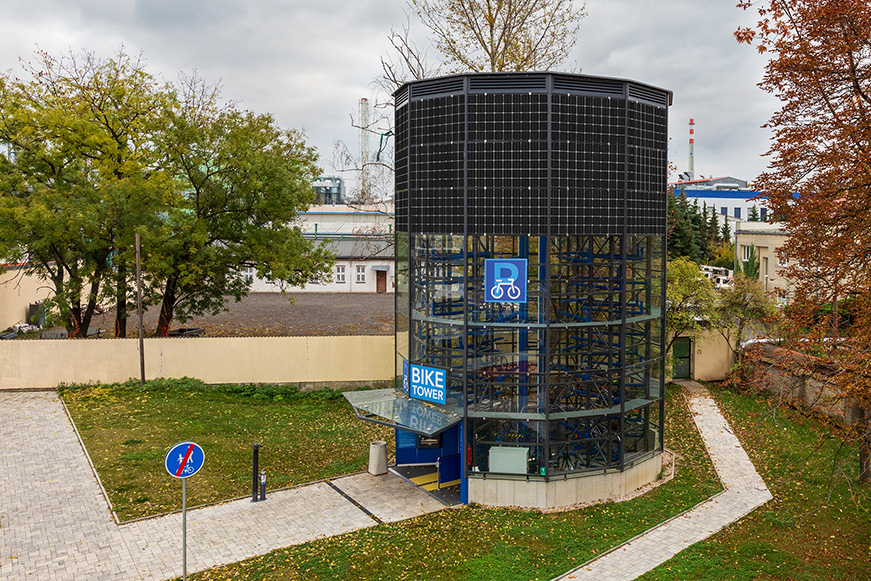A nice article by the major German public broadcaster’s news site. Translation by ChatGPT3.5:
The gloomy outlook on the future is countered by the genre Solarpunk: It creates online in art and literature a future worth living in, and one that might even be attainable.
Green meadows dotted with individual solar panels, with cows dozing in the shade. Floating balloons resembling turbines, with rotors generating electricity. Artificial cloud formations created above a small cultivation area that rains just enough to make the land fertile. Solar-powered, autonomously flying buses connecting the countryside with the city. It sounds like a utopia, a utopia of a world where people live in harmony with nature and use technology in a gentle manner.
These described scenes are from an anime that can be found on YouTube and represent a trend that has been growing in social networks in recent years: Solarpunk. It’s a sustainable, green utopia expressed in art, design, and mostly in short stories and literature. Initially, it was primarily an internet phenomenon focused on aesthetics.
A Future in Harmony with Nature
The term “Solarpunk” emerged in 2008 through a blog post and initially described only a literary genre that evolved from science fiction, particularly climate fiction. This idea is not entirely new, especially when examining feminist science fiction from the 1970s. For example, in Marge Piercy’s utopia “Woman on the Edge of Time,” she sketched a world contrasting the sexist and racist present of that time. It depicted a world where racism and gender differences were abolished, and small collective communities engaged in environmentally conscious practices while using their advanced technologies to maintain their quality of life.
The term “Solar” symbolizes ecological sustainability, and “Punk” in this context represents rebellion, inclusion, diversity, and a counterbalance to capitalism. It’s a counterproposal to the retro-oriented Steampunk and nihilistic Cyberpunk genres. Solarpunk aims to look forward with hope and counter the dystopian and post-apocalyptic narratives.
Instead, as noted by journalist Michael Förtsch, who is knowledgeable in the field of science fiction, the genre seeks to offer a positive or at least hopeful perspective on the future. A future where humanity strives to exist sustainably in harmony with the environment.
From Imagination to Reality
According to Förtsch, there are already approaches to this concept in our world today: “We can adapt our lives to better cope with climate change. We have technologies like solar and wind power, battery systems, and sustainable architecture. But we also have the opportunity to change our lifestyles and consumption habits by repairing devices, reducing waste, and producing food locally.” This is the idea that artists in the Solarpunk genre embrace. “They are already envisioning that in the future, we will incorporate all these things into our lives.”
Förtsch states that Solarpunk is already being lived today, with people making their homes or villages self-sufficient through solar power or coming together to operate communal gardens. Designers are also taking inspiration from the Solarpunk movement. “Efforts are being made to develop clothing that generates electricity or umbrellas covered in fabric with integrated solar cells that you could use to charge your smartphone via USB, for example.”
Healthy, Realistic Hope Can Be Activating
This optimistic view of the future appears to be in stark contrast to Greta Thunberg’s admonition, “I don’t want you to be hopeful, I want you to panic,” from her speech at the World Economic Forum in Davos in 2019. Psychologist Lena Müller, who has been involved with “Psychologists for Future” since 2021, still regards Thunberg’s statement as valid and believes that the activist was trying to jolt people out of their lethargy. “Because fear is indeed a mechanism or an emotion that is very activating.”
However, Müller also believes that “healthy, realistic optimism” can help people when looking into the future. She has observed this in her work, where, for example, she assists people in workshops to better cope with their despair regarding climate change. “The goal of a climate movement is that we want to activate and motivate people to take action willingly.” A sense of powerlessness due to fear can be inhibiting. One should not downplay the situation but also not be thrown off course by it.
Hope Through Technological Advances
Climate researcher Michael Jakob, who has been monitoring climate policy for years, also believes that hope can be activating. “It’s not as if we will fall off a cliff if we exceed the target. Even if we have a warming of 2.3 degrees, it’s still better than three or four degrees.”
There will always be significant consequences, but they become more severe the higher the warming. “Fifteen years ago, the two-degree target sounded utopian, and the prospect of quickly transforming the energy system seemed distant.” Much has happened since then. Jakob finds hope in various elements: “One is technological development. Renewable energies have become so affordable that they are now economically profitable on their own, without needing climate protection as the main motivation.”
It’s not a guaranteed success, but “we still have a chance to turn things around,” says Jakob. He doesn’t believe it’s realistic to expect the entire society to enthusiastically embrace change. However, there need to be pioneers who demonstrate new possibilities and show that many things can be done differently while still having a good life. “I’m thinking of technologies, but also lifestyles, consumption patterns, and so on.” Financial incentives and infrastructure must also be created so that this process does not harm people.
Vision through Science Fiction
Climate researcher Michael Jakob considers genres like Solarpunk to be very important because they create positive visions in culture, art, and literature. “Many of the innovations that have been groundbreaking in recent decades were envisioned many decades before. Last year, I read the book ‘Neuromancer’ by William Gibson, who detailed the concept of the internet in the 1980s. And Jules Verne, who essentially foresaw space travel.”
Such visions are crucial, “so that we can imagine what the world could look like if we change,” and not succumb to a state of “Climate Doom,” which is despair, according to Jakob. It’s necessary to believe that there are still opportunities for action.
That aesthetic reminds me of a cool contraption I’ve seen called the Bike Tower

Most of them don’t have solar panels anymore. Maybe not worth it at this angle?
Wow you are everywhere on Lemmy! I went on their website and it seems the solar panels are a new addition, so older bike towers weren’t made with them.
Thanks for posting this, many of us appreciate active communities on slrpnk.net, without seeing where it originated. Noting the “hopeful vs panic” issue, we shouldn’t waste our energy disputing “optimistic” or “pessimistic” visions - both are useful to help people to think, what’s important is to reject “fatalistic” thought.
About the art we see on slrpnk.net, it seems to me most of the buildings tend large, and like those of an architect selling grand projects, rather than buildings crafted by individuals on a smaller scale - is that intentional ?
Regarding the global warming goals, indeed 2.3 - while not good enough to avoid many critical impacts - is still better than 3 or 4, so we have made progress bending the projection curves since these began in 1990s. Having a long experience of such scenarios I’m trying to make an interactive tool to help illustrate such changes.
About the art we see on slrpnk.net, it seems to me most of the buildings tend large, and like those of an architect selling grand projects, rather than buildings crafted by individuals on a smaller scale - is that intentional ?
Right? Having read books such as Cities for People (Jan Gehl), I understand that a human and walkable scale is paramount for cities worth living in. For people to feel connected to their city, a maximum of about 5 levels off the ground seems to be best. I can kinda confirm this from my own experience having lived in all kinds of neighbourhoods throughout Germany.
Generally density is desirable, though, to allow for efficient heating, public transport as well as lively neighbourhoods. But cities need to develop their density in the right ways. A dense Barcelona neighbourhood feels the complete opposite of some giant Sovjet housing, albeit the densities might be similar.
@garden_boi @benjhm 5 stories is also more practical from a construction and maintenance perspective. You can use a lift to get a new AC condenser to the top of a 5-story building, but for 10 you’d need a crane or other apparatus. Same for repairing siding or replacing windows, or constructing the building in the first place. 5 stories is about the maximum height we can reasonable conduct maintenance from the ground.
People’s imagination of smaller, human scale stuff might be a little out of whack because most of us are surrounded by large buildings. Also, in a solarpunk future these buildings would not just suddenly disappear, but be reused and fitted with more vertical gardens and solar panels
There are propably two reasons for those giant builings:
- Old school science fiction art, which is often optimistic, but tends to like large scale stuff, because bigger is better.
- Architects selling their visison. It is reasonably common for architects to just design a dream building with unlimited budget and those tend to be massive. Right now there is a trend to stick plants on every part of a building, to make them appear more enviromentally firendly. That is usually not the case, but it does look cool.
It’s already getting real, and once organic photovoltaics will gain traction, the die is cast
And yt is literally flooded with solar panels + storage instructions for dyi and explanations.







